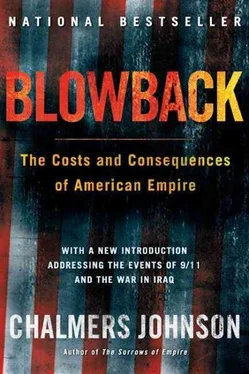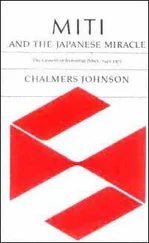Chalmers Johnson - Blowback, Second Edition - The Costs and Consequences of American Empire
Здесь есть возможность читать онлайн «Chalmers Johnson - Blowback, Second Edition - The Costs and Consequences of American Empire» весь текст электронной книги совершенно бесплатно (целиком полную версию без сокращений). В некоторых случаях можно слушать аудио, скачать через торрент в формате fb2 и присутствует краткое содержание. Год выпуска: 0101, ISBN: 0101, Издательство: Macmillan, Жанр: Старинная литература, на английском языке. Описание произведения, (предисловие) а так же отзывы посетителей доступны на портале библиотеки ЛибКат.
- Название:Blowback, Second Edition: The Costs and Consequences of American Empire
- Автор:
- Издательство:Macmillan
- Жанр:
- Год:0101
- ISBN:9780805075595
- Рейтинг книги:5 / 5. Голосов: 1
-
Избранное:Добавить в избранное
- Отзывы:
-
Ваша оценка:
- 100
- 1
- 2
- 3
- 4
- 5
Blowback, Second Edition: The Costs and Consequences of American Empire: краткое содержание, описание и аннотация
Предлагаем к чтению аннотацию, описание, краткое содержание или предисловие (зависит от того, что написал сам автор книги «Blowback, Second Edition: The Costs and Consequences of American Empire»). Если вы не нашли необходимую информацию о книге — напишите в комментариях, мы постараемся отыскать её.
Blowback, Second Edition: The Costs and Consequences of American Empire — читать онлайн бесплатно полную книгу (весь текст) целиком
Ниже представлен текст книги, разбитый по страницам. Система сохранения места последней прочитанной страницы, позволяет с удобством читать онлайн бесплатно книгу «Blowback, Second Edition: The Costs and Consequences of American Empire», без необходимости каждый раз заново искать на чём Вы остановились. Поставьте закладку, и сможете в любой момент перейти на страницу, на которой закончили чтение.
Интервал:
Закладка:
When it comes to an issue like land mines, a civilian president, even one with better command credentials than Clinton, can no longer afford to cross his military leaders. Similarly, it is hardly imaginable today that a president could support something like an international criminal court that offers the threat, no matter how distant, of putting American men in uniform (or their civilian surrogates around the world) at risk of indictment. George Washington’s Farewell Address now reads more like a diagnosis than a warning: he counseled Americans to “avoid the necessity of those overgrown military establishments, which under any form of government are inauspicious to liberty, and which are to be regarded as particularly hostile to Republican Liberty.”
When, in Rome, the U.S. representative expressed fears of “politically motivated charges” against Americans, he was actually worrying about, among other matters, situations in which Americans might use a brutal local military to undermine what it deemed an “unacceptable” regime, as has happened numerous times in the past—in Prime Minister Patrice Lumumba’s Congo in 1961, in President Ngo Dinh Diem’s South Vietnam in 1963, and in President Salvador Allende’s Chile in 1973. Such activities have often been foreshadowed by the military “training” programs the United States has long conducted with the militaries of other nations around the world.
In 1987, in fact, the government created a new Special Operations Command headquartered in Tampa, Florida, and placed it under an equally new assistant secretary of defense for special operations and lowintensity conflict. The command’s purpose was to consolidate and coordinate the activities of the forty-seven thousand “special forces” groups scattered across the military’s complex organizational charts, including the army’s Green Berets, Rangers, and covert Delta Force; the Navy’s SEALS and covert Team 6; and the special operations and commando units of the air force and the Marine Corps. One of the sponsors of this new structure was William Cohen, then a Republican senator from Maine, whose “keen interest in special operations” Washington Post reporter Dana Priest has noted “dates back decades.” 7Some military professionals and observers discount special operations because they do not rely on traditional military subdivisions and because they cost so little money compared with carrier task forces or B-2 bombers. Their political clout, however, vastly exceeds their budgetary needs and they were in no way “downsized” after the end of the Cold War. These covert units work closely with the Central Intelligence Agency and the Pentagon’s Defense Intelligence Agency (DIA). Programs like the CIA’s efforts at an army base in Colorado and in Okinawa until 1968 to train some four hundred Tibetan exiles to fight the Chinese or the CIA’s vast operations in supplying weapons to guerrillas harassing the Soviet forces in Afghanistan during the 1980s have now been turned over to the Special Operations Command.
In 1991, Congress inadvertently gave the military’s special forces a green light to penetrate virtually every country on earth. It passed a law (Section 2011, Title 10) authorizing something called the Joint Combined Exchange Training (JCET) program. This allowed the Department of Defense to send special operations forces on overseas exercises with military units of other countries so long as the primary purpose of the mission was stated to be the training of our soldiers, not theirs. The law did not indicate what JCET exercises should train these troops to do, but one purpose was certainly to train them in espionage. They return from such exercises loaded with information about and photographs of the country they have visited, and with new knowledge of its military units, terrain, and potential adversaries. As of 1998 the Special Operations Command had established JCET missions in 110 countries.
The various special forces have interpreted this law as an informal invitation to train foreign military forces in numerous lethal skills, as well as to establish relationships with their officer corps aimed at bringing them on board as possible assets for future political operations. Most of this has been done without any oversight by Congress, the State Department, or ambassadors in the countries where JCET exercises have been conducted. As a series of exposé articles in the Washington Post indicated in 1998, most members of the foreign policy apparatus had never even heard of JCET, and the assistant secretary of defense in charge of these special operations was noticeably vague in his answers to congressional questions about the programs. 8
It has only slowly come to light, for instance, that in JCET exercises Americans offered crucial training to the Turkish mountain commandos, who in their ongoing operations against their country’s rebellious Kurdish population have killed at least twenty-two thousand people; that during 1998 multiple special forces operations were carried out in each of the nineteen countries of Latin America and in nine Caribbean nations; and that United States special forces units have given training in such skills as advanced sniper techniques, close-quarters combat, military operations in urban terrain, and psychological warfare operations to military units in Colombia, Rwanda, Surinam, Equatorial Guinea, Sri Lanka, Pakistan, and Papua New Guinea, among other nations. In each of these cases, they were acting in violation of U.S. human rights policies and sometimes of direct presidential or congressional prohibitions. (For example, special operations training continued in Colombia even after President Clinton had “decertified” that country for most military aid and assistance.)
The Washington Post obtained a copy of a 1990 Department of Defense manual entitled Doctrine for Special Forces Operations , which describes the main activity of special forces on JCET missions as giving instruction in FID, or “foreign internal defense.” In other words, most of the training exercises are meant to prepare foreign militaries for actions against their own populaces or rebel forces in their countries. The manual defines FID as organizing, training, advising, and assisting a foreign military establishment in order to protect its society from “subversion, lawlessness, and insurgency.” Brig. Gen. Robert W. Wagner of the U.S. Southern Command in Miami told Douglas Farah of the Washington Post that FID is the “heart” of special operations, and an officer of the U.S. Army’s Special Forces Command assured Dana Priest that FID is “our bread and butter.” FID is, of course, hardly what Congress specified in the law as the function of JCET, but congressional control over military activities is by now so minimal that the Pentagon pays little attention to specifications that are displeasing. Stripped of its euphemistic language, FID amounts to little more than instruction in state terrorism. Republican representative Christopher Smith, chairman of the House of Representatives Subcommittee on International Operations and Human Rights, says, “Our joint exercises and training of military units—that have been charged over and over again with the gravest kind of crimes against humanity, including torture and murder—cry out for explanation.” But the U.S. secretary of defense seems to be unconcerned. “In those areas where our forces conduct JCET,” Secretary Cohen averred, “they encourage democratic values and regional stability.” 9
Just how JCET training contributes to “democratic values and stability” is nowhere better illustrated than by the case of Indonesia, a place Secretary Cohen has visited often to review the results of America’s educational efforts. Indonesia is the world’s fourth most populous country and the world’s largest Islamic nation. During its early years, after fighting for its independence from the Netherlands, when its founder and leader was President Sukarno (like many Indonesians, including General Suharto, he has only one name), it was a champion of neutralism and a thorn in the side of American foreign policy. Many CIA covert operations were mounted against Indonesia in that period, including during the revolution of 1965, when Suharto came to power, ousted Sukarno, and in a bloody pogrom eliminated leftist forces throughout the islands. Suharto and the army ruled with a strong authoritarian hand until May 1998.
Читать дальшеИнтервал:
Закладка:
Похожие книги на «Blowback, Second Edition: The Costs and Consequences of American Empire»
Представляем Вашему вниманию похожие книги на «Blowback, Second Edition: The Costs and Consequences of American Empire» списком для выбора. Мы отобрали схожую по названию и смыслу литературу в надежде предоставить читателям больше вариантов отыскать новые, интересные, ещё непрочитанные произведения.
Обсуждение, отзывы о книге «Blowback, Second Edition: The Costs and Consequences of American Empire» и просто собственные мнения читателей. Оставьте ваши комментарии, напишите, что Вы думаете о произведении, его смысле или главных героях. Укажите что конкретно понравилось, а что нет, и почему Вы так считаете.










